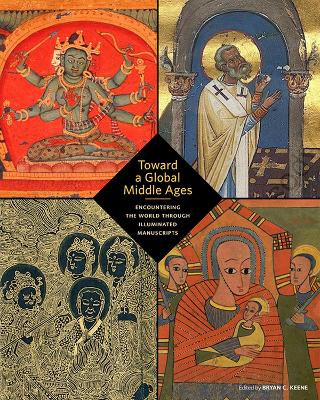Reviewed by annieb123 on
Toward a Global Middle Ages is a scholarly collection of essays and expostulatory writing around the premise that there is academic benefit in viewing and researching contemporaneous manuscripts from all over the world together, not just "Eurocentric" or "Asiatic" or "African" studies as they have been grouped in the past.
Due out 3rd Sept 2019 from Getty publications, it's a lushly illustrated 296 pages and will be available in softbound format.
The sheer magnitude of the scope of this volume intrigued me when I read the description. The history of textual objects is so inextricably intertwined in my mind with the social and cultural landscapes which created them as to make them indelibly linked to those cultures. To study them as a whole based on a time period (the middle ages) instead of viewing them from an individual cultural standpoint was new to me. I was excited to delve into this volume and learn what common threads the contributors could weave together from the disparate historical timelines.
First, the illustrations are absolutely breathtaking and the reproduction quality is high, even in the eARC I was given for review. I have no doubt that the quality of the print book will be much higher. The final physical size of the book is 8x10 inches (20x25cm) and it's paperbound, so it's not a 'coffee table' book, but it is full size and the illustrations are spread evenly throughout all the essays.
There are 27 individual contributor essays as well as introductory foreword from the Director of the Getty Museum, Timothy Potts, and a comprehensive prologue and introduction by the editor, Bryan C. Keene. The last chapter of the introductory section contains an explanatory timeline which is well referenced and gives good source material for further reading.
The next four sections (the bulk of the book) contain an interesting grouping of essays on cartography, the various book forms (bound, rolled, and folded), cultural and socio-ethnic identity in the medieval world, and travel and exchange of ideas in the medieval world. These essays are broadly different from one another, and are written by a range of academics with different areas of expertise. I found them interesting (and well written and researched), with a great deal of resources and references for further reading.
Obviously this is an academic treatise written by academics mostly for other academics or especially interested laymen. As such, it isn't an easy read. The language is rigorous and formal. I definitely don't think it's inaccessible for the average reader, but it will take some effort (and I think that's a good thing).
Some small details about the manuscript. Each of the pages for each contributor essay is labeled in the left footer margin with the author's name to more easily locate specific passages. The book pages are also numbered clearly in the footers. Footnotes and references are clearly delineated in the individual essays.
The book closes with an epilogue by James Cuno, a comprehensive bibliography, and a cross referenced index.
Difficult but enlightening reading. This would make a good support text for classroom or library use, for manuscript history, history of the middle ages, and similar subjects, as well as a superlative read for the particularly book-history-interested.
Five stars. Some of the essays are more accessible than others.
Disclosure: I received an ARC at no cost from the author/publisher for review purposes.
Reading updates
- Started reading
- Finished reading
- 18 August, 2019: Reviewed
